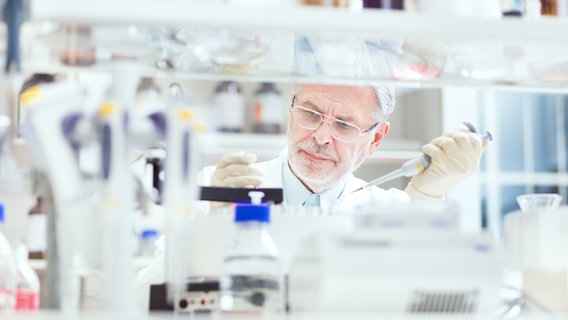Status: 03/23/2023 1:20 p.m
PFAS are used in industry in the manufacture of many products. But they accumulate in the body and the environment and are considered harmful. What can consumers pay attention to?
Packaging for chips, coated frying pans or rain and outdoor jackets: these and other products contain so-called PFAS (pronounced: Pefas), a group of water, grease and dirt-repellent chemicals. However, because the substances do not or hardly degrade in nature, they accumulate in the environment and in the human body and, according to experts, endanger our health. The European Environment Agency warns of some serious damage to health.
How toxic are PFAS?
According to the Federal Environment Ministry, not all substances are PFAS known, nor their use. While PFAS are not acutely toxic, they can be harmful to the environment and human health. In recent years, some PFAS have been shown to have harmful effects on health. Since they are very durable, they are also referred to as “forever chemicals”. Humans can ingest PFAS primarily through food and drinking water. After According to research by NDR, WDR and Süddeutsche Zeitung, far more places in Germany are contaminated by PFAS than previously assumed.
PFAS can be harmful to health
According to toxicologist Dr. Marike Kolossa-Gehring from Federal Environment Agency High concentrations of PFAS in the blood can have a number of adverse health effects, including damage to organs (e.g. thyroid and liver), cause cancer (e.g. testicular cancer), reduce the effectiveness of vaccinations and fertility and promote obesity, high blood pressure and disorders of sugar and lipid metabolism.
Where are PFAS found?
The senses cannot tell if a product contains PFAS because the chemicals cannot be seen, smelled or tasted. Due to their water, grease and dirt-repellent properties, PFAS are used in numerous everyday products.
- Pans, raclette grills, waffle irons, sandwich makers
- baking paper
- Fast food packaging (e.g. burger boxes, French fries bags, doner kebab bags)
- dental floss
- water filter
- Shampoo
- Cosmetics
- rain jackets
- crop protection products
- carpets
- Waterproofing sprays for textiles and shoes
- Waxes and lubricants (e.g. in ski waxes)
- Anti-fog agents (e.g. for glasses)
- Kabelummantelungen
- photographic papers, adhesive labels
- printing inks and varnishes
- fire-fighting foams
- electronic devices
- heat pumps
According to Kolossa-Gehring, the level of exposure to PFAS for consumers depends on various factors, such as where they live. Air, soil and water are mainly at “PFAS-Hotspots” heavily contaminated. In these places, drinking water and home-grown vegetables can be correspondingly highly contaminated. But personal behavior also plays an important role, emphasizes Kolossa-Gehring: “Anyone who avoids products with per- and polyfluorinated alkyl substances does not bring them into circulation and does not expose them to their own bodies. This ensures that PFAS do not spread further enrich”.
Avoid PFAS in food
Kolossa-Gehring recommends eating foods such as fish, seafood, meat and eggs in moderation and not more than twice a week, as they are often heavily contaminated. Offal should not be on the menu at all or only rarely. According to the toxicologist, fast food and frozen products such as ready-made pizza are also contaminated with PFAS because of their disposable packaging.
Further information
Avoid PFAS in pans and baking dishes
Not all coated pans and baking tins are finished with PFAS. But this is often loud Consumer Center This is the case if these must not be heated above 200 degrees or not empty. Even if the coatings are not allowed to come into contact with pointed objects or only with wooden and plastic spatulas, this can be an indication of the use of PFAS. According to Kolossa-Gehring, if you want to be sure that you are using PFAS-free pans, you should use uncoated pans made of stainless steel or enamel.
The chemicals PFOA and PFOS, two of the more than 10,000 total PFAS substances, are already banned. However, the consumer advice center warns: If manufacturers advertise their products with the words “PFOA/PFOS-free” or “GenX-free”, these often contain other PFAS substances.
Tips to avoid PFAS in everyday life
- Use reusable packaging made of glass, ceramic or metal for food
- When buying new outdoor clothing, shoes and impregnating agents, look for the information “fluorine-free”, “free from PFC” or “without PFAS”.
- Avoid textiles, clothing, upholstery and carpets labeled “stain-resistant”, “water-repellent”, “oil-repellent” (may contain PFAS)
- Avoid cosmetics with “fluoro” in the name of an organic ingredient
- Avoid paper, cardboard, cloth, plastic-free disposable tableware, and other materials if oil forms spherical droplets on the surface
How does PFAS get into drinking water, food and other products?
When processed in industry, PFAS are released into the air and water via exhaust fumes and waste water. They get into the soil and thus into food and drinking water via rain, snow and irrigation in agriculture. The substances were also used in the extinguishing foam of fire extinguishers for a long time and seeped into the soil. PFAS are distributed via rivers and seas to the most remote places on earth. They can be found, for example, in animals such as polar bears, but also in our blood, in mother’s milk and in plants.
Why aren’t PFAS banned?
According to the Federal Environment Ministry, a ban on the use of PFAS is very complex. There is currently no official record of all nationwide claims. In addition, there is still a lot of ambiguity about the exact composition, effect and use of the huge group of substances PFAS. There are already limit values or bans for some substances. But companies have so far often switched to alternative PFAS, which the Federal Environment Agency classifies as similarly worrying. The EU has opened a public consultation on PFAS until September 2023. Then she will about a PFAS ban decide.
Further information




